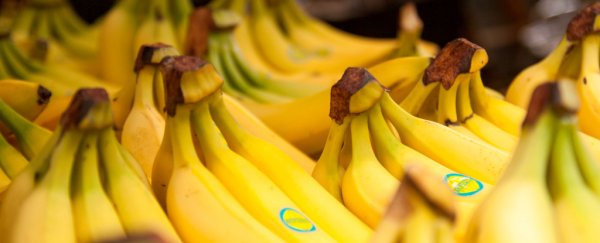Scientists have sequenced the genomes of three fungal diseases that currently threaten banana crops, and found something disturbing - the fungi have evolved to the point where they could wipe out the most popular banana crops in five to 10 years.
Before you let the darkness of a world without bananas swallow you up, the good news is that now we know the genetic sequence of these fungi, we have a good chance of being able to save our favourite fruit species.
"In reality, the global banana industry could be wiped out in just five to 10 years by fast-advancing fungal diseases," a statement from study leaders from the University of California, Davis, explains.
The news comes after we found out last year that another type of fungi not studied in this paper, Panama disease, had breached quarantine efforts and spread across South Asia, Africa, the Middle East, and Australia, posing a serious threat to banana crops.
But for this research, the team looked at a disease called Sigatoka, which is caused by three types of fungi, and already reduces banana yields by 40 percent every year.
For the first time, scientists from the University of California, Davis and the Netherlands sequenced the genomes of all three Sigatoka strains - yellow Sigatoka (Pseudocercospora musae), eumusae leaf spot (Pseudocercospora eumusae), and black Sigatoka (Pseudocercospora figiensis).
They found that the strains had actually become more dangerous, and no longer just hijack banana's immune system, but also their metabolism.
"We have demonstrated that two of the three most serious banana fungal diseases have become more virulent by increasing their ability to manipulate the banana's metabolic pathways and make use of its nutrients," said one of the researchers Ioannis Stergiopoulos.
"This parallel change in metabolism of the pathogen and the host plant has been overlooked until now and may represent a 'molecular fingerprint' of the adaption process," he added.
"It is really a wake-up call to the research community to look at similar mechanisms between pathogens and their plant hosts."
The researchers say that the fruit (or, arguably, berry or herb, depending on your definition) suffers from an 'image problem', where everyone assumes they'll be around forever because of how common they are, but in reality, they're particularly vulnerable to pathogen species.
This is because pretty much all commercial bananas are of the Cavendish variety, and unlike other crops, they're grown from shoot cuttings, rather than seeds.
"The Cavendish banana plants all originated from one plant and so as clones, they all have the same genotype - and that is a recipe for disaster," said Stergiopoulos.
In other words, a disease capable of killing one plant could kill them all.
So, what's the answer? One of the best solutions would be to develop a new banana cultivar, outside of the Cavendish variety that we've come to love and stock in supermarkets everywhere.
But, as Bec Crew reported for us last year, that takes a lot of time and money.
Instead, scientists might be able to use these new genetic sequencing results to modify Cavendish bananas to be resistant to the three strains of Sigatoka disease - or come up with new fungicides that interrupt the fungi's ability to hijack banana's metabolism.
Either way, the reality is that bananas are in trouble - a lot more than most of us realise. So go out and appreciate those golden parcels of delight while they're still available at a reasonable price, because even if we can help them avoid extinction, they won't be this abundant forever.
The research has been published in PLOS Genetics.

